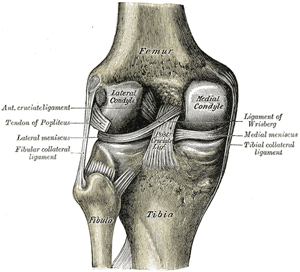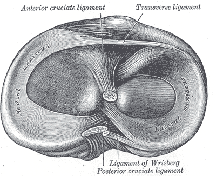By Bernie Clark, April 12th, 2013
It is a burning pain; sometimes sharp, stabbing; felt when the knee is flexed and the foot brought closer to the groin such as in sitting cross-legged or in Pigeon pose. Sometimes it is bearable, and you just sit with it hoping that you aren’t doing any real damage. Sometimes, however, it is unbearable and you know that damage has already happened. Welcome to the world of the meniscus.
There are four simple things that we can try to do to reduce or eliminate pain in the knee, but to understand why these work, first we need to understand a bit about the anatomy of the knee.The knee joint allows flexion and extension: bending and straightening the leg. Normally this is all that we require, however, when the knee is bent the ligaments that support the leg when it is straight are lax and this laxity allows for another degree of movement at the knee: twisting.
 You can see in this picture that there are two side ligaments: the lateral collateral ligament (which runs along the outside of the knee) and the medial collateral ligament (which runs along the inside of the knee.) These two tough bands of collagen prevent the knee from sliding from side to side. At the top of the tibia (the largest of the two lower leg bones) is a plateau, and at the bottom of the femur (the large upper leg bone) is another plateau. The two, approximately flat plates, do not fit together perfectly; in between them are two C-shaped pieces of cartilage called the menisci: the lateral (outer) and medial (inner) meniscus help the femur to slide on the tibia when the knee bends. They act as shock absorbers as well as ensuring a snug fit for the plateaus when the knee is straight.
You can see in this picture that there are two side ligaments: the lateral collateral ligament (which runs along the outside of the knee) and the medial collateral ligament (which runs along the inside of the knee.) These two tough bands of collagen prevent the knee from sliding from side to side. At the top of the tibia (the largest of the two lower leg bones) is a plateau, and at the bottom of the femur (the large upper leg bone) is another plateau. The two, approximately flat plates, do not fit together perfectly; in between them are two C-shaped pieces of cartilage called the menisci: the lateral (outer) and medial (inner) meniscus help the femur to slide on the tibia when the knee bends. They act as shock absorbers as well as ensuring a snug fit for the plateaus when the knee is straight.
 Preventing the two bones from sliding off their plateaus in the forward or backward direction are the two cruciate ligaments: the anterior cruciate, and behind it the posterior cruciate ligament. Finally, to help prevent the knee from going too far past straight into hyper-flexion is the patella: the kneecap.
Preventing the two bones from sliding off their plateaus in the forward or backward direction are the two cruciate ligaments: the anterior cruciate, and behind it the posterior cruciate ligament. Finally, to help prevent the knee from going too far past straight into hyper-flexion is the patella: the kneecap.
When we flex the knee the collateral ligaments become lax enough to allow twisting to occur. This is not possible nor desirable when the leg is straight but this fact of anatomy may be responsible for the pain you have been feeling while sitting in many yoga poses. To fully understand that, we also need to know what is happening with the hip socket.
 When the femur rotates in the hip socket (known as the acetabulum) it will eventually reach its full range of motion, either when the ligaments surrounding the acetabulum have stretched fully or when the neck of the femur hits the acetabulum. When the femur can rotate no more, the stress goes to the next joint down the line: the knee. External rotation of the femur in the hip socket allows us to bring the foot inward and lift it up towards the opposite thigh, as happens in Lotus pose. However, if the external rotation of the femur is insufficient to achieve this position, and because the collateral ligaments are lax when the knee is bent, the knee can twist, allowing some extra range of motion, allowing the foot to come higher up. Achieving a pose through twisting of the knee may make us feel like we are flexible and making good progress in our practice, but relying upon the knee to get us into an externally rotated position is a recipe for pain and problems.
When the femur rotates in the hip socket (known as the acetabulum) it will eventually reach its full range of motion, either when the ligaments surrounding the acetabulum have stretched fully or when the neck of the femur hits the acetabulum. When the femur can rotate no more, the stress goes to the next joint down the line: the knee. External rotation of the femur in the hip socket allows us to bring the foot inward and lift it up towards the opposite thigh, as happens in Lotus pose. However, if the external rotation of the femur is insufficient to achieve this position, and because the collateral ligaments are lax when the knee is bent, the knee can twist, allowing some extra range of motion, allowing the foot to come higher up. Achieving a pose through twisting of the knee may make us feel like we are flexible and making good progress in our practice, but relying upon the knee to get us into an externally rotated position is a recipe for pain and problems.
While there are hip openers in yoga – there are NO knee openers in yoga! The knee does not do well when forced to twist. This can be especially harmful, not when the knee is bent but when a twisted bent knee attempts to straighten. Remember, when straight, the knee does not allow twisting – but trying to straighten a twisted knee can damage the ligaments of the knee. The problems that happen while the knee is bent mostly occur to the medial meniscus, and sometimes to the lateral collateral ligaments. If the hips are tight and the tibia is forced during external rotation upwards a crushing compression may occur to the inner knee, or too much stress may result in a stretching of the outer ligaments.
1) Sit up on something and bring the foot in closer:
Now, what can we do about the pain? The first thing that we can try is to sit up on a cushion or two and bring the foot in closer to the body. Now that we understand that a bent knee can twist, the more we bend the knee the most twisting can safely occur. If you feel pain in one knee when you sit cross-legged, bring the troubled leg’s foot in first. This allows more flexion of that knee and may be sufficient to stop the pain. Likewise, if you feel pain in Pigeon Pose or Swan, bring the front foot more in towards your hip, flexing the knee more, which allows for more twisting of the knee. Also, sitting higher changes the angle of the femur in the hip socket and may allow you to externally rotate your leg more, reducing compression in the knee. Even in Pigeon you can “sit higher” by placing a cushion under your front leg’s hip.
Bringing the foot in closer or sitting up higher may reduce some of the intended sensations while in the pose, which you don’t want to happen, but if it is a choice between getting a juicy hip opener or sacrificing your knee, the choice is obvious: save the knee!
2) No Pain No Pain!
The single biggest thing you can do for your knee is to adopt the attitude that pain is not good for us. Rather than ignore the tweaky feeling, honor it. If you feel pain in the knee the body is trying to tell the mind something important: listen! Find a place where is no pain, and if that means not doing the pose – so be it: don’t do the pose. There are always other ways to work the targeted area of the body. You do not have to break your knees in the process.
3) Support the thighs
If the stress from externally rotating your leg is going from the hips to the knees, simply placing a block or folded blanket under the thigh may be all it takes to eliminate the stress in the knee. The support will now bear the weight of the leg, not the ligaments or meniscus. Even for those who feel very open in the hips and externally rotated, try using a support under the thigh – just as an experiment. You might be surprised to find that you can relax the legs more completely when they are supported.
4) Placing support behind the knee
Try placing a rolled up towel or washcloth behind the knee, or use a yoga strap that has been folded several times. Pull it up tight behind the knee as you flex the leg. You may find that this is all it takes to relieve all the pain symptoms. By propping the knee from behind it will feel like you have created space in the knees, allowing more room between the tibia and femur, thus preventing the compression on the meniscus. [Note, while this may be great for someone with meniscus issues, it may not be advisable for someone with cruciate ligament problems: in that case we don’t want to create more space in the knee because the cruciate ligaments may already be too lax.]
When you practice any hip openers during yoga (yin or yang), pay attention to the knees; if they start to talk, try the above suggestions. For more discussion on how to safely work the knees, visit the YinYoga.com Forum where there are several threads on this topic. To help with recovery from a damaged knee, you may also want to review this article on Yin Yoga for the Knees from an earlier Newsletter.
(Back to Newsletter #15)
